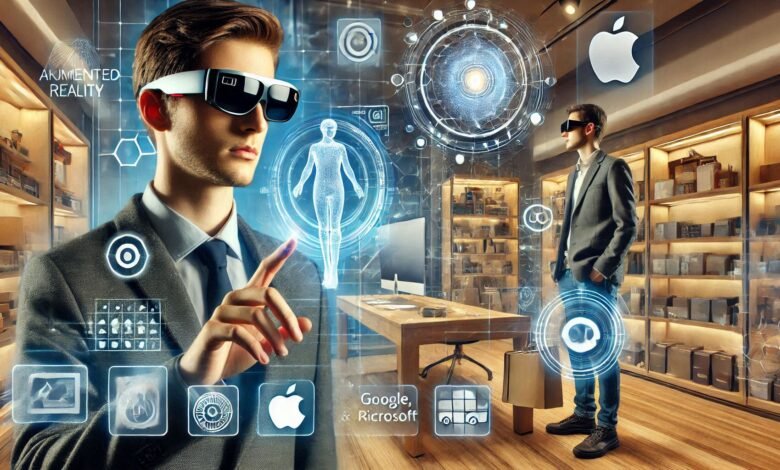
In the past ten years, there has been a big change in technology, thanks to people who have found new ways to combine the real and digital worlds. The use of augmented reality (AR) has changed the way companies interact with their customers and the environments they work in, from retail to healthcare. Younger people, who are very interested in AR technology, are particularly aware of this change.
The potential of AR to create immersive, interactive digital experiences has changed the way customers connect with businesses in a big way, and its impact has skyrocketed in 2024. As AR keeps getting better, it will likely change even more industries, making them more intriguing for users and helping businesses grow.
Key TakeAways
- Augmented Reality (AR) growth: The AR market is growing quickly thanks to new products from big companies like Magic Leap, Apple, and Google. AR is changing everything from shopping to healthcare by creating immersive experiences that keep customers interested and make operations run more smoothly.
- Market Potential: AR is expected to bring in $40,4 billion by 2024, which is 65% of the market for spatial computing. Both consumer-facing apps like virtual try-ons and business-focused apps like digital twins contribute to this growth.
- Focus on business: Tech companies like Microsoft and PTC are focusing on business AR applications in fields like manufacturing and healthcare. These apps use AR to boost productivity and streamline processes by providing real-time data visualization and remote help tools.
- Retail and Marketing Revolution: Companies such as ArtLabs and Meta are leveraging AR to significantly transform social media and online shopping. ArtLabs, for instance, has no-code tools that let stores turn 2D images into interactive 3D models, which makes online shopping more fun.
Why Augmented Reality (AR) Technology is Here to Stay?
AR companies are experts at combining digital material with the real world to make experiences better in real time. Augmented reality is changing how we interact with each other online. Virtual try-ons and immersive game experiences are just two examples of its many uses.

Reports say that augmented reality (AR) makes up 65% of the market for spatial computing and will bring in $40.4 billion in 2024, thanks to new products from big tech companies.
As companies continue to use AR to change how we see the world and completely transform industries, find out more about the companies that are at the leading edge of AR innovation.
Related: 10 Best Metaverse Platforms to Watch in 2023
List of Leading-Edge AR Companies to Watch in 2025
In 2025, these companies will have the most market share in augmented reality. When it comes to making new software and hardware, these companies are pushing the limits and setting the bar for innovation in augmented reality.
1. Apple
Apple consistently pushes the boundaries of technology, as evidenced by its Vision Pro headset and ARKit, a software development kit designed to create AR experiences on iOS devices. Apple’s RealityKit, an augmented reality (3D) framework, blends real-world and virtual environments to produce more immersive experiences. With AR Quick Look and other features, users can now see 3D models in real life. Apple is a leader in augmented reality (AR), and by buying companies like Metaio, it makes AR apps simple to use on iPhones and iPads.
2. Google
Google typically doesn’t passively observe the global adoption of new technologies. With AR tools like ARcore and Google Lens, the company is a significant player. Google Lens improves visual search, and ARCore lets developers make AR apps with features like tracking motion and understanding the surroundings. Google’s Maps AR Navigation changes the way people find their way around by adding digital directions on top of real-world locations. Google still invests in AR innovation, placing itself as a leader in the future of augmented reality, even though they put the promising Tango project on hold.
3. Meta (Facebook)
Meta, formerly known as Facebook, has also ventured into the realm of AR. Spark AR tools primarily enable creators to create interactive AR effects for social media. Meta’s plan for the future includes using augmented reality (AR) in its work in the metaverse to connect the real and digital worlds. The smart glasses that the company is making with Ray-Ban aren’t fully AR-capable yet, but Meta’s big project, Project Nazare, aims to make AR experiences more realistic without using smartphone screens. The company’s purchases of gear like the Oculus Rift help AR technology move forward.
4. Microsoft
Microsoft entered the augmented reality (AR) market with the HoloLens, a mixed-reality headset mainly made for business use that has advanced holographic computing and gesture tracking. By connecting to Azure Spatial Anchors, developers can make AR apps that are aware of their surroundings, which makes them more interactive in the real world. Microsoft is a leader in business-focused AR solutions, while many of its rivals focus on consumer markets. Its main areas of focus are healthcare, education, and manufacturing. With better tracking and a more comfortable design, the HoloLens 2 is even better than the first one. It offers smoother, more immersive augmented reality experiences that are perfect for work and industry settings.
5. Unity
Unity Technologies is a leader in augmented reality (AR) development. It provides a complete set of tools that developers can use to make immersive AR experiences in a wide range of fields. With Unity’s AR Foundation, developers can make AR apps that work on both iOS and Android, which makes the process of making apps easier. Unity’s dedication to making games accessible has led to big hits like Pokémon GO and increased the use of AR in areas like design and cars. Also, Unity’s MARS platform makes AR experiences better, which makes it one of the most flexible and powerful AR tools available.
6. Qualcomm
Qualcomm’s Snapdragon XR chip is a key part of making improved AR and VR experiences possible. Qualcomm is still pushing AR technology forward with the Snapdragon XR2 Gen 2 chip, which has faster processing speeds and better AI skills. Qualcomm holds a significant position in the AR industry, with its processors powering numerous AR devices like the Meta Quest 3 VR headset. Their smart investments in 5G technology make sure that AR apps, especially those that run on smart glasses, have low latency, which makes experiences smoother and more engaging.
7. Magic Leap
Corporate augmented reality (AR) apps utilize Magic Leap’s cutting-edge spatial computing technology. Magic Leap’s platform, Magicverse, combines virtual and real worlds, adding digital layers to fields like manufacturing, healthcare, and defense. It has received over $3.5 billion in funding. The Magic Leap 2 headset, which is coming out soon, will improve the AR experience by making images clearer and giving businesses more powerful apps. One of the few companies that builds hardware specifically for enterprise AR solutions is Magic Leap.
Also Read: How to Create a Successful 3D and AR Strategy for Your Business
8. Groove Jones
Groove Jones is a business that makes AR/VR apps and is known for making experiences that are immersive and interactive. They focus on educational, promotional, and brand activation apps and provide lively brand activations, interactive demos, and fun training programs that improve how users interact and learn. Groove Jones has been a leader in the AR/VR space since 2015. They have worked on well-known projects like the ServiceNow NHL Shot Challenge and the AI-powered Aura Photo Experience at Coachella.
Conclusion
The augmented reality (AR) market is growing very quickly. Big names like Apple, Google, and Magic Leap, as well as new companies, are driving AR growth in many areas.
AR companies are changing how many fields approach immersive experiences, from marketing and eCommerce to teaching employees and using AR in the workplace. Businesses can gain a significant competitive edge by keeping up with the latest developments from these key innovators as AR technology becomes increasingly prevalent in customer interaction strategies, operational processes, and employee training.
Now is a good time for companies that are thinking about adopting AR to look into how these technologies can change operations, improve customer experiences, and streamline processes. This will help companies stay ahead in a digital world that is always changing.











